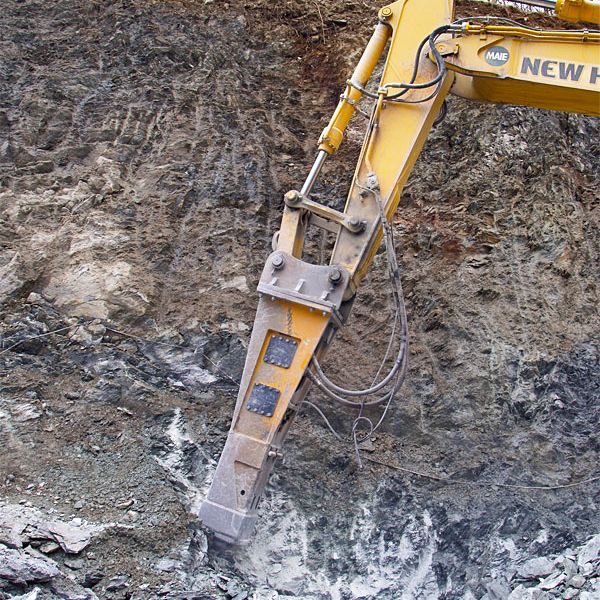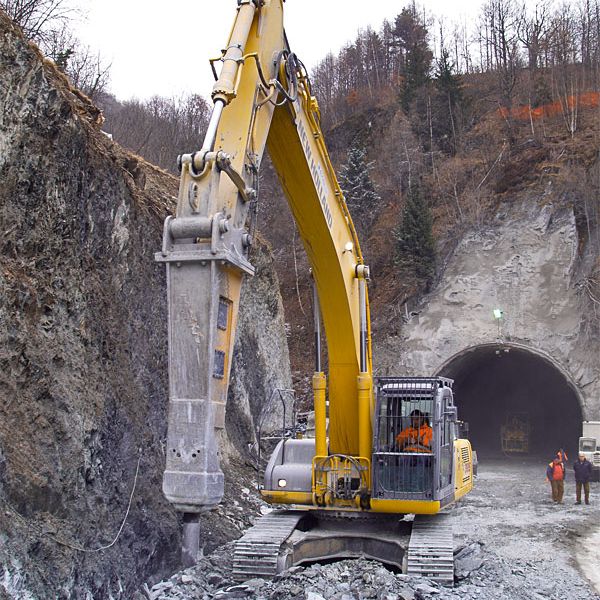More solid than the rock
The location is breathtaking: on the SS39 Aprica highway on the southern slopes of the Alps - this year's harsh winter weather and the late spring combine to make this an even tougher assignment than expected.
The site we are visiting today is run by Accisa SpA, based in the Lombard town of Dalebio, near Sondrio, in northern Italy. Two tunnels are being built (400 and 200 metres long, respectively) along the state highway between Edolo and Tresenda.
An engineer by trade, now technical director and site manager for Accisa SpA, Massimiliano Duca explains that this is an improvement to the road. The road used to narrow as it approached some bends, preventing two trucks from passing each other in opposite directions – whereas under the new plans, the road will be widened, enabling the traffic to flow much more smoothly.
A tough site
The Edolo site – close to San Sebastiano named after St. Sebastian’s church perched right above the tunnel – has involved considerable external earthworks (more than 4000 m3) almost exclusively carried out by an Indeco HP 5000 hydraulic breaker.
This was a particularly tough task due to the nature of the rock which responds poorly to blows from a breaker. Indeed, it is obvious to the onlooker that the breaker tool penetrates very easily but, despite this, production is poor. This type of rock produces no bad side effects for the tool, but rather the whole structure of the breaker is subject to considerable stress. The equipment should be used to shatter and not to rip, but here the tool simply cuts all the way through the rock, forcing the operator to use leverage to break the rock. This is an improper use of the breaker, but we have no real choice – so if a piece of equipment can withstand stress of such magnitude, then that means it really is solid.
As far as the tunneling work is concerned, at the time of our visit, the first twenty metres are so had been dug – the men from Accisa are going ahead with a combined operation of perforation (using the Jumbo) and explosives. Once the explosives have done their job, it’s time for the chisel-finish, followed by boulder clearance using the Indeco breaker. During this phase, we can eat away into the rockface another half a metre beyond where the drill got to, and working manually with the breaker gives the rock a good profile, enabling hazardous boulders to be removed, and creating the right safety conditions for mounting the steel ribs.
The reliability of a breaker in such a situation is therefore fundamental: if it broke, it would affect both the tunnelling work, and the laying of the new road surface. But on the SS39 site, the only problems they have come across so far have been due solely to the freezing cold, which reduces the efficiency of the automatic greasing system, which is obviously badly affected by low temperatures. This was a problem until the tunnelling work began, but now that the breaker can be kept “indoors”, that is no longer an issue.
Equipment at work
Forepoling for the job began in early February, whereas the whole job (including both tunnels) should be completed by the end of 2010, with the Edolo tunnel being ready by the end of the summer. Ten people are at work on the site, using the various equipment present: a New Holland 385 excavator equipped with an Indeco HP 5000, a hydraulic jumbo drill, a Caterpillar loader, two Perlini rigid dump trucks, a Manitou telehandler as well as forklift trucks, a shuttle and a steel rib handler, several generators and a Cifa shotcrete pump. Accisa have a true vocation for tunnelling – indeed, the company was founded in 2005 following the acquisition of a branch of Cetti SpA, and specialises almost exclusively in road and rail tunnelling, together with occasional consolidations and various types of roadworks apart from paving. They carry out these tasks in a vast area covering the whole of central and northern Italy.
The firm employs over thirty people, including technical planning staff for new projects. “Our experience with Indeco breakers,” explains Massimiliano Duca – began at the Firenzuola site (a tunnel dug using just breakers and no explosives), for which we rented from Maie in Ravenna two excavators, each equipped with an HP 5000, one of which we then bought. And today our fleet contains two HP 5000‘s, a choice which reflects the excellent performance provided by this equipment and by the advantages of greater spare part availability and better assistance, as well as a couple of smaller outdated Indeco breakers”.









